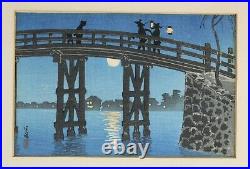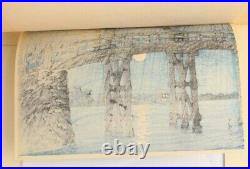





1920s-1930s woodblock print by Shin Hanga artist Takahashi Shotei. Very good condition, published by Watanabe. Measures 4.75″ H x 7.25″ W. The child who was later to be known as Takahashi Shtei was born, Matsumoto Katsutaro, in Mukoyanagiwara, Asakusa, Tokyo on January 2, 1871. As a child, he was adopted into the Takahashi family, becoming known as Takahashi Katsutaro. According to tradition, Fuko gave him his art name “Shotei” a variant of his own surname “Matsumoto”. The first Japanese character of their names is pronounced either “Sho” or “Matsu”. At the age of 16, he went to work at the Imperial Household Department of Foreign Affairs, where it was his job to copy designs of foreign medals, clothing, and other ceremonial objects. In 1889, along with Terazaki Kogyo, he founded the Japan Youth Painting Society (Nihon Seinen Kaiga Kyokai). During his early years, he produced and exhibited original paintings and also worked as an illustrator of scientific textbooks, magazines, and newspapers. In 1892, he designed woodblock prints for a magazine published by Okura Shoten. In 1896, he designed lithographs for the publisher Hokunkai. During this time, he placed highly in competition at various industrial exhibitions. Later, he worked for publisher Maeba Shoten (also known as Maehane Shoten) where he did line drawing and color separations for reproductions of Ukiyo-e prints. While working at Maeba Shoten, he became acquainted with Watanabe Shozaburo. In 1907, he was recruited as the first artist for Watanabe Shozaburo. He produced many original designs in the style of the Edo-era landscapes. In 1921, he started using the g “Hiroaki”, however, many of his new prints continued to display the “Shtei” seal through the 1930s. Up until the great Kanto earthquake, in September 1923, he produced as many as 500 print designs for Watanabe. Unfortunately, Watanabe’s entire publishing operation was destroyed in the fires which followed in the aftermath of the earthquake. After the disaster, he produced 250 more prints for Watanabe, some of which were reproductions of the older images lost in the fires. In the 1930s, while still working for Watanabe, he also designed some oban (and larger) prints for the publisher Fusui Gabo. It seems that he had considerably more artistic freedom working for Fusui and was allowed to explore areas which may have been off-limits under Watanabe. At Fusui, he also acted as an editor for their Ukiyo-e reproductions. Additionally, also in the 1930s, he produced almost 200 print designs for the publisher Shbid Tanaka. These included 12 mitsugiri-ban prints with approximately 180 prints in smaller sizes. The picture to the right is of Shtei and his wife Haru at Miyajima. My research has revealed different dates for his death from various sources. Roberts’ A Dictionary of Japanese Artists puts his death in 1944. The 1951 Watanabe catalog says he died in April, 1945, at Hiroshima. Still another source suggests that he died on August 6, 1945, a victim of the atomic bomb attack on Hiroshima, where he was visiting with his daughter. The truth of the matter is, according to the family records of his descendants, he died on February 11, 1945 of pneumonia. The item “TAKAHASHI SHOTEI Japanese Moon under a Bridge at Hakozaki Woodblock Print” is in sale since Tuesday, April 27, 2021. This item is in the category “Antiques\Asian Antiques\Japan\Prints”. The seller is “kylescrossroads” and is located in Glen Mills, Pennsylvania. This item can be shipped to United States, Canada, United Kingdom, Denmark, Romania, Slovakia, Bulgaria, Czech republic, Finland, Hungary, Latvia, Lithuania, Malta, Estonia, Australia, Greece, Portugal, Cyprus, Slovenia, Japan, China, Sweden, South Korea, Indonesia, Taiwan, South africa, Thailand, Belgium, France, Hong Kong, Ireland, Netherlands, Poland, Spain, Italy, Germany, Austria, Bahamas, Israel, Mexico, New Zealand, Philippines, Singapore, Switzerland, Norway, Saudi arabia, United arab emirates, Qatar, Kuwait, Bahrain, Croatia, Malaysia, Brazil, Chile, Colombia, Costa rica, Panama, Trinidad and tobago, Guatemala, Honduras, Jamaica, Antigua and barbuda, Aruba, Belize, Dominica, Grenada, Saint kitts and nevis, Saint lucia, Montserrat, Turks and caicos islands, Barbados, Bangladesh, Bermuda, Brunei darussalam, Bolivia, Ecuador, Egypt, French guiana, Guernsey, Gibraltar, Guadeloupe, Iceland, Jersey, Jordan, Cambodia, Cayman islands, Liechtenstein, Sri lanka, Luxembourg, Monaco, Macao, Martinique, Maldives, Nicaragua, Oman, Peru, Pakistan, Paraguay, Reunion, Viet nam, Uruguay, Russian federation.
- Region of Origin: Japan
- Color: Multi-Color
- Age: 1900-1940
- Primary Material: Paper
- Original/Reproduction: Vintage Original
- Featured Refinements: Japanese Woodblock Print
